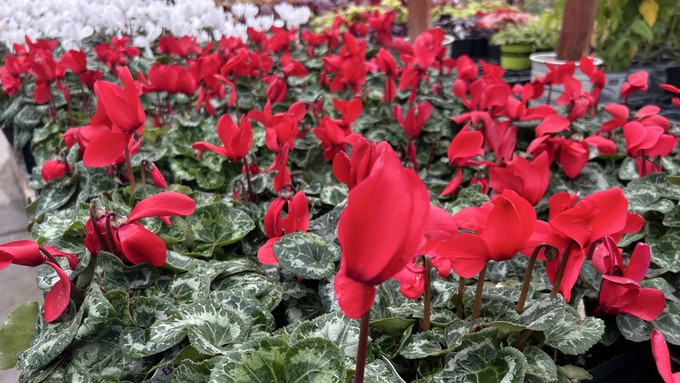
Expect a very wet Christmas week; make most of breaks between storms

Cyclamen are among the non-poinsettia favorites for cheery color during winter. Kathy Morrison
This week will feel like Santa sent us a whole lot of rain as three separate storm systems flow over Northern California – with a fourth close behind.
Saturday (Dec. 21), the shortest day of the year, also is the first official day of winter. If this week is any indication, it could be a very wet season.
According to the National Weather Service, a series of three storms in four days will march across the Sacramento Valley, headed to the Sierra. Saturday's showers started the soggy barrage followed by a second storm Sunday and a third arriving Monday night. That last system may be the strongest, delivering up to an inch of rain on Tuesday, Christmas Eve.
Right now, the forecast for Christmas Day (Wednesday) looks partly sunny and dry, with a high of 54 degrees in Sacramento. But by Thursday morning, another storm will arrive with more rain also forecast for Friday.
Get more Sacramento-area weather updates here: https://www.weather.gov/sto/#
Between showers this week, check on your garden’s welfare. Clean up fallen branches and other debris. Don’t let water pool near foundations.
When working (or just walking) in the garden, be careful of soggy ground; it can compact easily. Soggy soil also will rot newly planted bulbs. Wait until the soil is moist but not dripping wet.
* Rake leaves away from storm drains and gutters. Recycle those leaves as mulch or add to compost.
* Brighten the holidays with winter bloomers such as poinsettias, amaryllis and cyclamen indoors, and Iceland poppies, calendulas, pansies and primroses outdoors.
* Keep poinsettias in a sunny, warm location; bring them inside at night or if there’s rain. (They don’t like cold, wet weather.)
* Prune non-flowering trees and shrubs while they’re dormant.
* Clean and sharpen garden tools before storing for the winter.
* Rake and remove dead leaves and stems from dormant perennials.
* Seed wildflowers and plant such spring bloomers as sweet pea, sweet alyssum and bachelor buttons.
* Once soil dries out a little, trees and shrubs can be planted now, especially bare-root varieties such as fruit trees or rose bushes. This gives them plenty of time for root development before spring growth. They also benefit from winter rains.
* Plant bare-root berries, kiwifruit, grapes, artichokes, horseradish and rhubarb.
* Set out cool-weather annuals such as pansies and snapdragons.
* Lettuce, cabbage and broccoli also can be planted now.
Comments
0 comments have been posted.Sacramento Digs Gardening to your inbox.
Food in My Back Yard Series
April 29: What's (already) wrong with my tomato plants?
April 22: Should you stock up on fertilizer? (Yes!)
April 15: Grow culinary herbs in containers
April 8: When to plant summer vegetables
April 1: Don't be fooled by these garden myths
March 25: Fertilizer tips: How to 'feed' your vegetables for healthy growth
March 18: Time to give vegetable seedlings some more space
March 11: Ways to win the fight against weeds
March 4: Potatoes from the garden
Feb. 25: Plant a fruit tree now -- for later
Feb. 18: How to squeeze more food into less space
Feb. 11: When to plant? Consider staggering your transplants
Feb. 4: Starting in seed starting
Sites We Like
Garden Checklist for week of May 4
Enjoy this spring weather – and get gardening!
* Plant, plant, plant! It’s prime planting season in the Sacramento area. Time to set out those tomato transplants along with peppers and eggplants. Pinch off any flowers on new transplants to make them concentrate on establishing roots instead of setting premature fruit.
* Direct-seed melons, cucumbers, summer squash, corn, radishes, pumpkins and annual herbs such as basil.
* Harvest cabbage, lettuce, peas and green onions.
* In the flower garden, direct-seed sunflowers, cosmos, salvia, zinnias, marigolds, celosia and asters. (You also can transplant seedlings for many of the same flowers.)
* Plant dahlia tubers. Other perennials to set out include verbena, coreopsis, coneflower and astilbe.
* Transplant petunias, marigolds and perennial flowers such as astilbe, columbine, coneflowers, coreopsis, dahlias, rudbeckia and verbena.
* Keep an eye out for slugs, snails, earwigs and aphids that want to dine on tender new growth.
* Feed summer bloomers with a balanced fertilizer.
* For continued bloom, cut off spent flowers on roses as well as other flowering plants.
* Add mulch to the garden to maintain moisture. Mulch also cuts down on weeds. But don’t let it mound around the stems or trunks of trees or shrubs. Leave about a 6-inch to 1-foot circle to avoid crown rot or other problems.